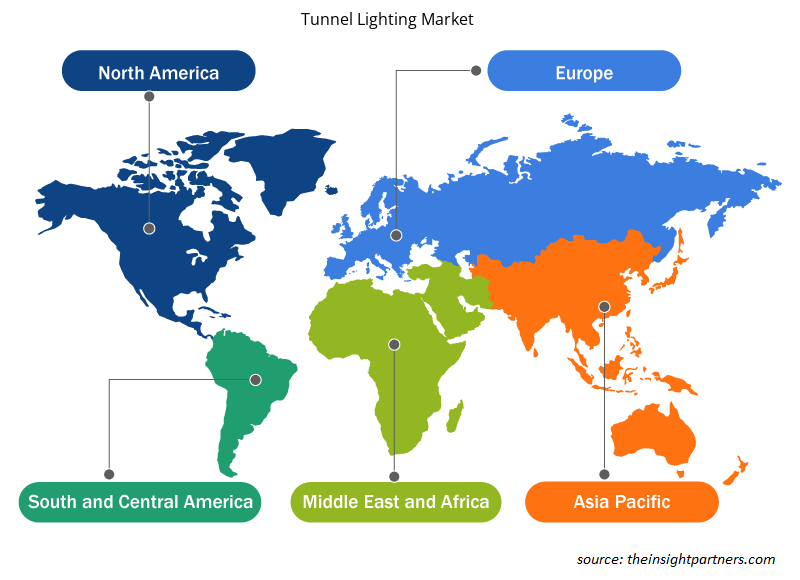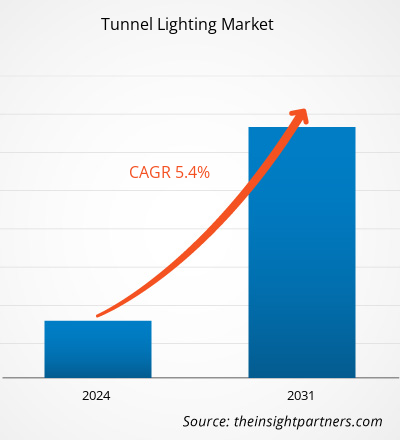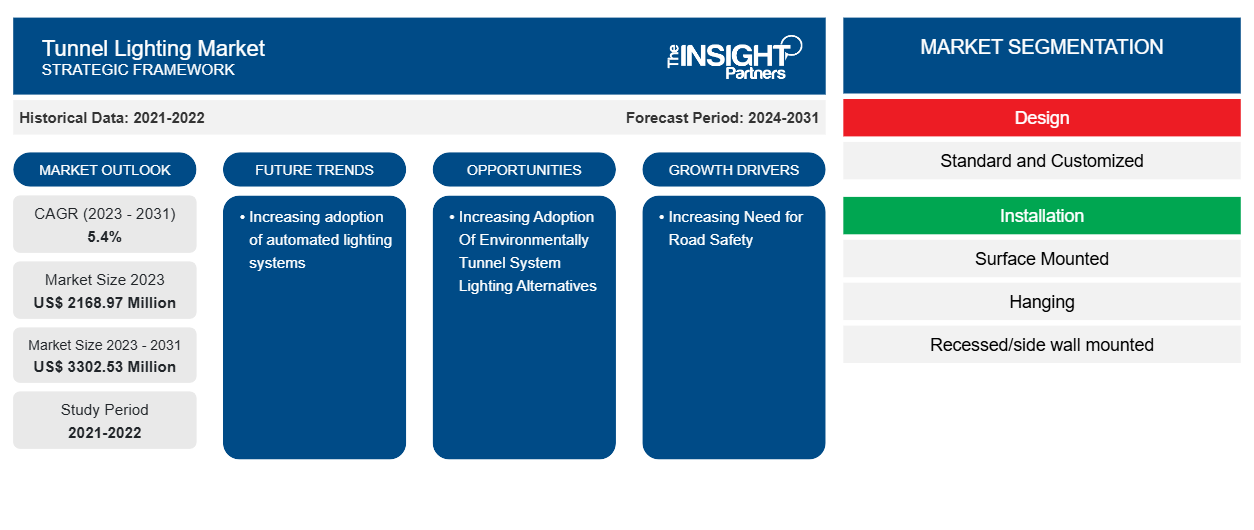Se proyecta que el tamaño del mercado de iluminación de túneles alcance los 3302,53 millones de dólares estadounidenses en 2031, frente a los 2168,97 millones de dólares estadounidenses en 2023. Se espera que el mercado registre una CAGR del 5,4 % durante el período 2023-2031. Es probable que la creciente adopción de sistemas de iluminación automatizados siga siendo una tendencia clave en el mercado.CAGR of 5.4% during 2023–2031. Increasing adoption of automated lighting systems is likely to remain a key trend in the market.
Análisis del mercado de iluminación de túneles
El ferrocarril desempeña un papel fundamental en el sistema de transporte de cualquier economía, ya que el desarrollo del comercio, la industria y el comercio depende en gran medida del desarrollo de la infraestructura de transporte. Los ferrocarriles no solo se consideran rentables, sino también una fuente de transporte confiable. Se pueden transportar grandes cantidades de mercancías y pasajeros a largas distancias con mínimas posibilidades de fallas o demoras en comparación con las carreteras. Además, la capacidad de carga de los trenes es elástica, ya que se puede aumentar o disminuir el número de vagones. Además, es uno de los medios de transporte más respetuosos con el medio ambiente, ya que los modernos motores ferroviarios funcionan con electricidad en comparación con los motores diésel convencionales. Debido a estos beneficios, los gobiernos de todo el mundo se centran cada vez más en el desarrollo de su red ferroviaria. Por lo tanto, se proyecta que el gran énfasis en el desarrollo de redes ferroviarias en todo el mundo impulsará el mercado de iluminación de túneles.
Descripción general del mercado de iluminación de túneles
Una buena iluminación del túnel garantiza que el conductor se adapte a la luz que hay en el interior del túnel a la entrada del mismo. Crea un entorno de conducción seguro al proporcionar una iluminación adecuada a lo largo del túnel. El conductor debe entrar en el túnel sin ningún impacto negativo, atravesarlo y salir del mismo. En particular, la iluminación diurna en los túneles tiene requisitos más específicos debido a los problemas de adaptación. Los bajos niveles de iluminación en el túnel harán que el conductor experimente ceguera temporal en la entrada del túnel y en el interior del mismo si ha estado expuesto a altos niveles de luz solar durante mucho tiempo. Por este motivo, la iluminación del túnel debe cambiarse gradualmente para permitir que el conductor se adapte.
Personalice este informe según sus necesidades
Obtendrá personalización en cualquier informe, sin cargo, incluidas partes de este informe o análisis a nivel de país, paquete de datos de Excel, así como también grandes ofertas y descuentos para empresas emergentes y universidades.
-
Obtenga las principales tendencias clave del mercado de este informe.Esta muestra GRATUITA incluirá análisis de datos, desde tendencias del mercado hasta estimaciones y pronósticos.
Factores impulsores y oportunidades del mercado de iluminación de túneles
Necesidad creciente de seguridad vial
Los túneles de carretera, especialmente los de autopistas, se encuentran entre las zonas más propensas a sufrir accidentes debido a la alta velocidad de los vehículos. Por ello, es importante mantener unas condiciones de iluminación suficientes en el interior del túnel para garantizar un flujo de tráfico fluido. Una iluminación óptima permite a los conductores de vehículos identificar obstáculos y navegar por el túnel sin reducir la velocidad. La Guía CIE para sistemas de iluminación de túneles obliga a los integradores de sistemas a tener en cuenta cinco áreas clave: sistema de iluminación de túneles en la zona de transición, sistema de iluminación de túneles en la zona de acceso, sistema de iluminación de túneles en la zona de salida y sistema de iluminación de túneles en la zona interior. Además, el sistema de iluminación de túneles en la zona de umbral y las crecientes redes de carreteras en terrenos remotos y montañosos están dando lugar a la construcción de nuevos túneles de carretera. Por tanto, el aumento del número de proyectos de desarrollo de túneles de carretera, junto con la creciente importancia de la seguridad vial, está impulsando el crecimiento del mercado de la iluminación de túneles.CIE Guidance for tunnel lighting systems compels system integrators to consider 5 key areas—transition zone tunnel lighting system, access zone tunnel lighting system, exit zone tunnel lighting system, and interior zone tunnel lighting system. Furthermore, the threshold zone tunnel lighting system and the growing road networks in remote and mountainous terrains are leading to the construction of newer roadway tunnels. Hence, the rise in the number of roadway tunnel development projects, coupled with the increasing importance of road safety, is driving the growth of the tunnel lighting market.
Aumento de la adopción de alternativas de iluminación para sistemas de túneles respetuosos con el medio ambiente
El problema de la iluminación que llega a los vertederos se ve agravado por el hecho de que varios de los equipos de iluminación que llegan a los vertederos son peligrosos. La iluminación fluorescente, que normalmente incluye bombillas de bajo consumo y tubos de iluminación, con frecuencia contiene mercurio y, por lo tanto, se clasifica como residuo peligroso según la Directiva RAEE adoptada tanto por el Reino Unido como por la Unión Europea (UE). Los equipos de iluminación son un peligro para la salud humana y el medio ambiente, con el riesgo de que materiales peligrosos contaminen el suelo, el aire y las aguas subterráneas. La remanufactura de la iluminación ofrece una alternativa más segura y protegida a esto. El proceso implica reparar o reemplazar componentes, desmontar los aparatos de iluminación usados y volver a montarlos en un estado satisfactorio que sea tan bueno como el original. Reducir los residuos electrónicos y extender el ciclo de vida de los productos ayuda a fomentar prácticas más circulares en la industria. Por lo tanto, la creciente adopción de alternativas de iluminación del sistema de túneles ambientales está creando más oportunidades para el mercado.WEEE Directive adopted by both the UK and the European Union (EU). Lighting equipment is a danger to human health and the environment, with the risk of hazardous materials contaminating the soil, air, and groundwater. Lighting remanufacture provides a safer and more secure alternative to this. The process involves repairing or replacing components, disassembling used lighting fixtures, and then reassembling them to a satisfactory condition that is as good as the original. Reducing electronic waste and extending the life cycle of products helps contribute to fostering more circular practices in the industry. Thus, the increasing adoption of environmental tunnel system lighting alternatives is creating more opportunities for the market.
Análisis de segmentación del informe de mercado de iluminación de túneles
Los segmentos clave que contribuyeron a la derivación del análisis del mercado de iluminación de túneles son el diseño, la instalación, el tipo y la aplicación.
- Según el diseño, el mercado de iluminación de túneles se divide en estándar y personalizado. El segmento personalizado tuvo una mayor participación de mercado en 2023.
- Por tipo de instalación, el mercado se segmenta en montaje en superficie, montaje colgante y montaje empotrado/en pared lateral. El segmento de montaje en superficie tuvo una mayor participación de mercado en 2023.
- Por tipo, el mercado está segmentado en iluminación LED, iluminación incandescente, iluminación fluorescente y otros.
- Por aplicación, el mercado está segmentado en túneles mineros, túneles de carreteras, túneles ferroviarios y otros.
Análisis de la cuota de mercado de la iluminación de túneles por geografía
El alcance geográfico del informe del mercado de iluminación de túneles se divide principalmente en cinco regiones: América del Norte, Asia Pacífico, Europa, Medio Oriente y África, y América del Sur y Central.
La región APAC domina el mercado de iluminación de túneles. El mercado de iluminación de túneles en esta región está creciendo debido a diversos factores, como el aumento de las iniciativas gubernamentales para mejorar la visibilidad de la iluminación de túneles y la presencia de una industria del transporte bien establecida. dominates the tunnel lighting market. The tunnel lighting market in this region is growing due to various factors, such as increasing government initiatives to improve the visibility of tunnel lighting and the presence of a well-established transportation industry.
Perspectivas regionales del mercado de iluminación de túneles
Los analistas de Insight Partners explicaron en detalle las tendencias y los factores regionales que influyen en el mercado de iluminación de túneles durante el período de pronóstico. Esta sección también analiza los segmentos y la geografía del mercado de iluminación de túneles en América del Norte, Europa, Asia Pacífico, Oriente Medio y África, y América del Sur y Central.

- Obtenga datos regionales específicos para el mercado de iluminación de túneles
Alcance del informe de mercado de iluminación de túneles
| Atributo del informe | Detalles |
|---|---|
| Tamaño del mercado en 2023 | US$ 2168,97 millones |
| Tamaño del mercado en 2031 | US$ 3302,53 millones |
| CAGR global (2023 - 2031) | 5,4% |
| Datos históricos | 2021-2022 |
| Período de pronóstico | 2024-2031 |
| Segmentos cubiertos |
A propósito
|
| Regiones y países cubiertos |
América del norte
|
| Líderes del mercado y perfiles de empresas clave |
|
Densidad de actores del mercado de iluminación de túneles: comprensión de su impacto en la dinámica empresarial
El mercado de iluminación para túneles está creciendo rápidamente, impulsado por la creciente demanda de los usuarios finales debido a factores como la evolución de las preferencias de los consumidores, los avances tecnológicos y una mayor conciencia de los beneficios del producto. A medida que aumenta la demanda, las empresas amplían sus ofertas, innovan para satisfacer las necesidades de los consumidores y aprovechan las tendencias emergentes, lo que impulsa aún más el crecimiento del mercado.
La densidad de actores del mercado se refiere a la distribución de las empresas o firmas que operan dentro de un mercado o industria en particular. Indica cuántos competidores (actores del mercado) están presentes en un espacio de mercado determinado en relación con su tamaño o valor total de mercado.
Las principales empresas que operan en el mercado de iluminación de túneles son:
- MARCAS DE ACUIDADO, INC.
- Fabricación Kenall
- Tecnología de iluminación Aeon Inc.
- Significar la celebración (Philips)
- Schreder-escuchar
- Iluminación Thorlux
Descargo de responsabilidad : Las empresas enumeradas anteriormente no están clasificadas en ningún orden particular.

- Obtenga una descripción general de los principales actores clave del mercado de iluminación de túneles
Noticias y desarrollos recientes del mercado de iluminación de túneles
El mercado de iluminación de túneles se evalúa mediante la recopilación de datos cualitativos y cuantitativos a partir de una investigación primaria y secundaria, que incluye publicaciones corporativas importantes, datos de asociaciones y bases de datos. A continuación, se enumeran algunos de los avances en el mercado de iluminación de túneles:
- Signify anunció la instalación de iluminación LED en el túnel Ahmed Hamdy 2, inaugurado recientemente. Signify utiliza los sistemas de iluminación más modernos que cumplen con las especificaciones internacionales para permitir el control remoto de la iluminación y, al mismo tiempo, ofrecer un ahorro energético de hasta el 70 %. (Fuente: Signify, comunicado de prensa, octubre de 2021)
- El Grupo Tungsram firmó en diciembre un acuerdo para instalar la iluminación del Túnel de Tresponts en España. El proyecto supone el sexto contrato de iluminación de túneles que la empresa con sede en Budapest ha conseguido en España en 2020, un logro considerable a la luz de las dificultades económicas provocadas por la pandemia del coronavirus. (Fuente: Grupo Tungsram, Nota de prensa, septiembre de 2022)
Informe de mercado sobre iluminación de túneles: cobertura y resultados
El informe “Tamaño y pronóstico del mercado de iluminación de túneles (2021-2031)” proporciona un análisis detallado del mercado que cubre las siguientes áreas:
- Tamaño del mercado de iluminación de túneles y pronóstico a nivel global, regional y nacional para todos los segmentos clave del mercado cubiertos bajo el alcance
- Tendencias del mercado de iluminación de túneles, así como dinámica del mercado, como impulsores, restricciones y oportunidades clave
- Análisis detallado de las cinco fuerzas de Porter y PEST y FODA
- Análisis del mercado de iluminación de túneles que cubre las tendencias clave del mercado, el marco global y regional, los principales actores, las regulaciones y los desarrollos recientes del mercado.
- Análisis del panorama de la industria y de la competencia que abarca la concentración del mercado, el análisis de mapas de calor, los actores destacados y los desarrollos recientes del mercado de iluminación de túneles
- Perfiles detallados de empresas
- Análisis histórico (2 años), año base, pronóstico (7 años) con CAGR
- Análisis PEST y FODA
- Tamaño del mercado, valor/volumen: global, regional y nacional
- Industria y panorama competitivo
- Conjunto de datos de Excel
Informes recientes
Testimonios
Razón para comprar
- Toma de decisiones informada
- Comprensión de la dinámica del mercado
- Análisis competitivo
- Información sobre clientes
- Pronósticos del mercado
- Mitigación de riesgos
- Planificación estratégica
- Justificación de la inversión
- Identificación de mercados emergentes
- Mejora de las estrategias de marketing
- Impulso de la eficiencia operativa
- Alineación con las tendencias regulatorias























 Obtenga una muestra gratuita para - Mercado de iluminación de túneles
Obtenga una muestra gratuita para - Mercado de iluminación de túneles